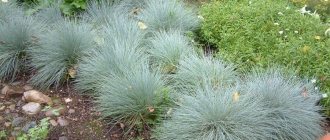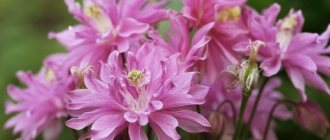Popular types and varieties of marigolds, known to every summer resident
thin-leaved marigolds or Mexican marigolds, thin-leaved Tagetes, or Mexican (Tagetes tenuifoia)
These are marigolds with the most unassuming appearance: 25-40 cm high with small (2-3 cm in diameter) single inflorescences and beautiful decorative highly dissected foliage.
But it is thin-leaved marigolds that are grown for food! Yes, you heard right, fine-leaved marigolds are actively used in flower cooking. However! They are not the only ones, read carefully our top marigolds!
Popular varieties and hybrids of fine-leaved marigolds
Marigold thin-leaved Red Gem (Gem) - height from 25 to 35 cm. Blooms with numerous reddish-brown flowers.
Tagetes thin-leaved variety Precious stone
Mexican marigolds Lemon Gem are bushes up to 35 cm high with lemon-colored flowers. Their peculiarity is small and curly reed petals, light green small leaves.
Marigold Mexican Lemon Gem
Floral cooking with marigolds
In flower cooking, the petals of fine-leaved marigolds are of particular value. They can be added to oil, vinegar or dough to give a golden color and original taste. They really like to top desserts with marigolds: it’s beautiful and you won’t accidentally poison your guests. In addition to marigolds, you can use calendula, nasturtium, roses, sage, lavender, thyme, etc. to decorate dishes.
Rejected marigolds or French marigolds, rejected Tagetes (Tagetes patula)
These are the most popular marigolds for the flower garden. A huge number of varieties of different heights, flower colors and shapes have been bred: there are varieties with a height of 15 cm to half a meter with simple, semi-double and double inflorescences with a diameter of 3 to 7 cm. The flowers can be yellow, orange-brown, orange and red.
Popular varieties and hybrids of rejected marigolds
Marigold rejected Red Cardinal (Red Cardinal) - bushes are spherical, densely branched, 40 cm high. The flowers are large, double, red-mahogany with a yellow border, 5-6 cm in diameter.
Marigold rejected Rusty Red is a small-flowered variety with double inflorescences 4-5 cm in diameter. Bushes 25-40 cm high. Flowers are dark red with a yellow border.
Marigolds rejected Red Cardinal and Rusty Red
Marigold rejected Hero - Super Hero series, early flowering varieties with compact bushes. The series has a wide palette of colors.
Marigolds rejected by Hero
Marigolds rejected Bonanza Yellow is the leader among marigolds in France, the Bonanza series of tagetes. The group is distinguished by the clean and rich colors of its large flowers. The flowers are double, up to 6 cm in diameter. The series is represented by 6 types of colors.
Marigolds rejected Bonanza Yellow
Erect marigolds, or erecta Tagetes (Tagetes erecta)
The largest of the marigolds! These are powerful bushes, 70-80 cm high with large inflorescences up to 10-12 cm in diameter! Flowers can be simple, semi-double or double, lemon, yellow or orange in color.
Popular varieties and hybrids of erect marigolds
Marigolds Beatles White Moon F1 is a beautiful hybrid of erect marigolds with a rare white color. 35 cm high, resistant to rain, wind and disease.
Marigolds Beatles White Moon F1
Marie Helen marigolds are tall marigolds with large, densely double inflorescences up to 9 cm in diameter. Flowering is early, abundant and long-lasting. Bushes up to 90 cm high. Suitable for cutting; stand in water for up to 15 days.
Caring for marigolds
Marigolds are so undemanding that you can almost forget about care. It is enough to regularly check whether all the plants are healthy and weed the flowerbed.
Temperature
Marigolds do not tolerate cold, and this is almost the only thing they do not like. But if you plant seedlings in a timely manner, when all the frosts have definitely passed, there will be no problems.
Photo: oir.mobi
Lighting
Marigolds do well in the shade. But if you want to achieve the most lush and lush flowering, choose a well-lit sunny area.
Photo: m.ok.ru
Watering
Marigolds do not need too intense watering, and when the bushes have already grown and become stronger, it can be reduced further. Because stagnation of moisture is the main enemy of your flowerbed, and the soil under the thick carpet of marigolds takes a long time to dry out.
Photo: fb.ru
The soil
The soil can be almost anything, but it must be very loose and breathable. Even strong marigolds with good immunity do not tolerate heavy soil.
Photo: oir.mobi
Fertilizers and fertilizing
Marigolds do not require mandatory feeding, but they are sensitive to it and grow even more intensely. It is recommended to apply fertilizer a couple of times per season only in poor soil. Use complex mixtures and not before the seedlings have completely taken root and grown at least 10 cm.
Photo: alt-ctrl-del.ru
Trimming
Marigolds do not require mandatory pruning, but they tolerate it easily, so you can safely form neat bushes. In addition, always remove faded buds and trim the thickest areas.
Photo: agrobiz.net
Smell
Marigolds have a rather pungent and strong odor. Whether you like it or not is a matter of personal preference, but be sure to keep this feature in mind. But there is also a plus: the natural phytoncides of the plant protect marigolds and nearby plantings well from diseases or fungi.
Photo: recipe-zdorovia.com
Flower Hazel grouse (50 photos): types, planting and care in open ground
Rare species of marigolds that deserve the attention of summer residents
Aniseed marigold, or aniseed tagetes, Mexican tarragon (Tagetes lucida)
These marigolds are not as effective in appearance as the three previous species, however, they are valued as an aromatic and medicinal crop. The aroma of the plant resembles a mixture of tarragon and anise, for which the plant is also known under such names as Mexican tarragon, Texas tarragon, Mexican calendula .
In nature, it is a perennial herbaceous plant, with a height of 30 to 70-75 cm. The stems are erect, the inflorescences are numerous baskets about 1.3 cm in diameter, collected in flat, apical semi-umbrellas, yellow. Blooms from August until frost. Since 1798, it has been grown in Europe as an aromatic summer plant.
The most famous and aromatic cultivar, Huichol, is a traditional clone used by the Huichol Indians of Mexico.
Anise marigold, or Mexican tarragon
Small marigolds or small Tagetes (Tagetes minuta, Tagetes glandulifera)
Miniature marigolds are native to South America. In Argentina, Chile, Bolivia and Peru they were used as a seasoning, for making drinks and for medicinal purposes. In the United States, marigold seasoning can be purchased as a paste in jars, and you can also find crushed and frozen leaves for sale.
Marigolds are small
Lemon marigolds or lemon tagetes (Tagetes lemmonii)
Also known as Copper Canyon Daisy, Mountain Marigold, and Mexican Marigold
Mountain marigolds from the canyons of southern Arizona. They are decorative shrubs, in nature reaching a height of 2.4 m and blooming with single yellow flowers with a smell reminiscent of lemon and mint. The foliage is sharp.
Tagetes filifolia
These marigolds are prized for their edible foliage, which has a sweet flavor with a strong licorice and anise aroma. In cooking they can be used as a substitute for tarragon.
The bushes are spherical in shape, in the middle zone they grow up to 35-40 cm in height. The leaves are thin and tender.
Best grown in long day conditions. With short daylight hours, flowering begins, after which the plant dies.
Suitable for growing in containers with herbs and flowers. The crop is undemanding to soil and easily tolerates drought.
Marigolds
Nelson's marigolds, or Nelson's tagetes (Tagetes nelsonii)
Mexican species of marigold. An annual herbaceous plant with a height of 50 cm to 2 m. Also known as citrus scented marigold. In Mexico and Guatemala, its flowers are eaten raw.
Pest and disease control
The most common marigold disease is blackleg, which causes the stem to die at the base. It cannot be stopped, so diseased plants must be destroyed by the roots. And for prevention, treat the seeds and soil with fungicides before planting.
Root rot occurs more often in mature plants, and the bush begins to wither. Alas, the situation is the same - diseased flowers need to be destroyed. And for prevention, choose loose soil, do not allow water to stagnate, and weed weeds regularly.
In dry, hot weather, spider mites may appear and cover the plant with a coating. It is easy to fight with insecticides, infusions of aromatic herbs and simply regular spraying, because it does not like moisture. Ticks are also repelled by the smell of petunias and tansy.
Thrips love to eat buds and are very difficult to spot. Aphids eat almost everything in their path. And caterpillars, slugs and snails eat the leaves. In all cases, insecticides cope. Large pests, such as snails and slugs, will first have to be removed mechanically.
Photo: forum.prihoz.ru
Daffodils (60 photos): types, planting and care in open ground
Planting seeds in the ground
Marigolds are easy to grow from seeds. Planting in flower beds begins at the end of May, when the soil warms up well. It is better to choose an open sunny place, away from bodies of water, light partial shade is allowed. For convenience, furrows can be made with a hoe, then spilled with water.
The seeds are laid out approximately 1.5-2 cm apart, and sprinkled with 0.5-1 cm of soil. Next, the plantings are watered and covered with covering material so that the moisture does not evaporate so much, of course, if rain is forecast, then this is possible not to do.
After about five days, marigold shoots will appear, the covering fabric is removed, if there is severe drought, the plants need watering. When the second pair of true leaves appears, the places where the marigolds have grown densely are thinned out. Excess plants can be planted in beds with cabbage, tomatoes, peppers, and carrots. The fact is that all parts of marigolds secrete phytoncides, which repel pests and fight pathogenic microflora, including such a common fungus as late blight.
When planting these plants, depending on the variety, certain conditions are observed. So between tall marigolds you need to keep a distance of about 40 cm, between medium-sized plants keep 30 cm, and low marigolds are planted at a distance of 15-20 cm.
Features of cultivation
Thin-leaved marigolds, for all their general unpretentiousness, are somewhat more demanding in terms of light, amount of heat and soil composition than rejected marigolds.
At temperatures even a few degrees below zero, plants can die. If the average daily temperature drops below +10°C for a long time, the leaves of the plants will acquire a reddish tint, and growth and flowering will stop. True, high temperatures combined with high humidity are also not very desirable, since marigolds produce a lot of foliage and flowering becomes poor.
In sunny areas, thin-leaved marigolds will show themselves in all their glory. In partial shade they will also live and even bloom, but flowering will be delayed and minimal. Flowers show particular demands on lighting in the first weeks of their development.
These flowers will feel best on light, sandy, neutral or slightly acidic soils. Overmoistening of the soil can be disastrous for them, but they can withstand drought quite well, especially during the flowering period.
For fertilizing, it is advisable to use phosphorus-potassium fertilizers with a minimum nitrogen content.
After flowering in late autumn, the marigold bushes are best crushed and embedded in the soil. Thus, you will improve and improve its composition.
With these lovely sunny flowers you can create spectacular flower beds in your garden without much effort. In addition, their presence will improve the soil on the site and drive away uninvited guests from it, in the form of various insect pests.
Marigolds can be considered the most popular flower crop among gardeners. They are unpretentious in care, and after planting seedlings in a flowerbed, they begin to bloom almost immediately. They are used not only in landscape design of personal plots, but also for decorating flower beds in parks and alleys. It is also used as a medicinal component in folk medicine and even in the preparation of some dishes.











